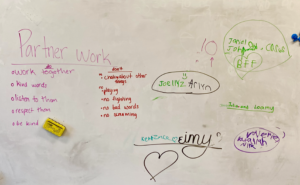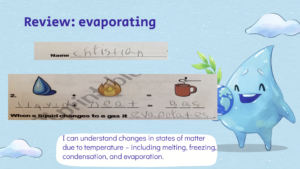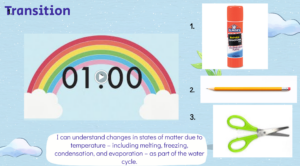Norms and Values
Jill and I worked together to help the students feel a sense of security in our classroom community. Partner and group work exposed some behavioral and social challenges as a result of the pandemic. When introducing collaboration, we intentionally involved students in the process of constructing expectations. When students collaborated, our class created a ‘contract’ of how we would work with partners. Students then signed the contract to show that they agreed to uphold the expectations we developed together. It was an incredibly powerful experience to witness students taking ownership of their collaboration.

Jill and I intentionally worked to engage students in metacognition as frequently as possible. We encouraged students to reflect on their learning, choices, and behavior through a daily reflection log. When students were actively reflecting on their learning, there were notable shifts in their ownership over their work.
We also worked very hard to ensure that students’ hard work and accomplishments were celebrated. When a student made significant progress towards a challenging goal, improved their letter formation, or finally moved on to a new Lexia level, we made a point to celebrate their accomplishment with the class (with their permission). When we would review learning from a previous lesson, I frequently worked to incorporate student work as definitions. For example, when reviewing changing states of matter, I took pictures of student work and utilized them in our review slides (with student permission). This was a very effective tool for engaging students who were feeling particularly down about finishing an assignment slower than their peers….etc.

I noticed over time that students began emulating this attitude of celebrating each other in their interactions with each other. I noticed that when I would compliment a student for helping another student who was struggling, they would immediately point out how hard the student had worked and show how with just a little push they were able to get it. I also noticed that intentionally celebrating students’ hard work rather than achievements created a growth mindset among our students. Students became motivated to persevere through difficult and challenging work when Jill and I recently celebrated one of their peer’s hard work.
Equity and Access
Our classroom is home to 18 unique learners – including my mentor, Jill, and myself. Out of our 16 students, all besides two speak Spanish as their primary language outside of school. Four languages are spoken in our classroom – with three of those four spoken on a daily basis on the classroom. At any given moment, it wouldn’t be unusual for a guest to overhear students discussing classwork in Portuguese, Spanish, English, or a hodgepodge of all three.
All students are on Individualized Education Plans (IEPs), 504s, are being evaluated for one, or are being considered for evaluation. This makes learning in our classroom a very unique experience that differs from many other classrooms.
While it is nearly impossible to document every single scaffold present in our classroom due to the sheer volume of legally mandated scaffolds, the below list provides a brief snapshot of what scaffolding may look like when planning a short lesson.
-
-
- Dictation support is provided to all students during independent or partner work where instructions are written.
-
- Dictation occurs when instructions are given (whole group) and again once students are working independently or with partners.
-
- Visual timers for each step of activities and transitions.
- Students are engaged in total physical response as frequently as possible.
- At the beginning of a topic, we always build background as a class.
- When learning new vocabulary students are given opportunities to share how they would describe something depicted in an image in their own words (English or another language)
- While all students are held to the same firm goals, students are provided with flexible means to meet these goals as frequently as possible.
-
- For example, students who struggle with letter formation may demonstrate their knowledge of the different climate zones by sorting rather than writing.
-
- Dictation support is provided to all students during independent or partner work where instructions are written.
-
